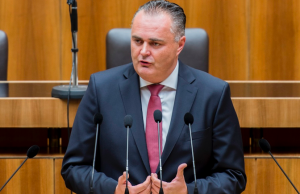A federal state in eastern Austria has become a role model for Europe: Burgenland covers its entire electricity demand by using renewable energy sources. Furthermore, it produces so much electricity to provide other regions with it. This could be done all over Europe. It only takes political willpower.
Read this article in German here.
At first sight, the narrow strip of countryside in the east of Austria, Burgenland, has little in common with Iceland. Flat plains here – rugged cliffs there. The quiet Lake Neusiedl in Burgenland – steaming geysers on the small island in the North of Europe. Vineyards here – moss landscapes there. But as different as the regions may be, both manage to make the most of their geographical advantages and generate energy from it. While Iceland mainly uses geothermal sources, Burgenland relies on wind power.
Burgenland and Iceland demonstrate: Europe could end the exploitation of fossil and nuclear sources. This is also confirmed by a study of the Institute for Transformative Sustainability Research (IASS). All that is necessary is for each region to recognise and utilise its individual potential to generate electricity.
No coal, no oil, no nuclear power: Europe could become 100 percent self-sufficient
The IASS examined that Europe could generate 14,560.4 terawatt hours (TWh) of electricity from renewable energy sources. This compares to a total consumption of 3,204.2 TWh. In other words: Europe could satisfy its demands 4.5 times over – only from renewable sources. To illustrate this, the IASS has created an interactive map that visualises the energy demand in each region and how much electricity could be generated from renewable energy sources.
Regions that can easily cover their needs are green. Areas where it is difficult to do so, are red. What stands out: Apart from the large metropolitan areas such as Vienna, Prague, Brussels, Budapest or Berlin, the all regions in Europe are green. But even those frew red spots could be supplied by surrounding regions.
Due to the variety of landscapes and climates in Europe, production shortages could easily be avoided. If there’s no wind in Burgenland, the missing electricity could be generated by solar power plants in Italy and vice versa. This is also underlined by Tim Tröndle from the IASS:
“a self-sufficient Europe, completely based on renewable Energy, is possible. especially if trade is established between regions and countries.”
Renewable energy: Burgenland keeps its promises

However, many European regions don’t use their potential. Politicians are afraid to break with the coal industry. In Burgenland, the situation is different: In 2006, the local parliament decided that the federal state has to meet its entire electricity demand by using renewable energy sources until 2013. Not only did Burgenland keep this promise, it even went further: It now covers 150 per cent of its electricity demand by renewable energy sources and can thus supply other regions with electricity.
In comparison: In 2000, the share of renewable energy sources was only 3 percent.
419 million euros for green electricity to combat climate change
Burgenland is not yet satisfied and plans to invest more in wind power. By 2025, the federal state will put 419 million euros into this project. This will increase wind-based electricity by 25 percent, but also expand network capacity and multiply electricity production from photovoltaics by 10 per cent. In this way, solar energy will become the second pillar of Burgenland’s energy strategy. In addition to that, the money will be used to finance the ecologisation of public transport.
29 hydrogen busses for Burgenland
In another project, Burgenland plans to integrate hydrogen-powered busses in the federal state’s transport network. Additionally, the hydrogen needed for this will be generated in Burgenland. Energie Burgenland boss Michael Gerbavsits explains:
“Energie Burgenland* will build the electrolysis units for this project and thus produce the hydrogen needed to operate the busses.”
(*the state owned energy company, editors note)
Organic will become standard – one third of the region’s area under nature conservation

Burgenland is a role model when it comes to climate-neutral electricity generation, but it also focusses on climate protection: More than a third of its surface is under nature conservation and the agricultural sector relies on organic farming.
For the provincial government of Hans-Peter Doskozil (Social Democratic Party), organic products shall become standard. Therefore, he has come up with an ambitious 12-point-plan. For example, permits for new stables will only be granted if they are certified as organic. Nevertheless, the federal state is also aware of its responsibility as a major consumer and wants to gradually increase the amount of organic products in state and state-near kitchens and buffets: In 2021, 50 percent of meals will be organic and in 2024, 100 percent. The same will be implemented in nursery schools.
